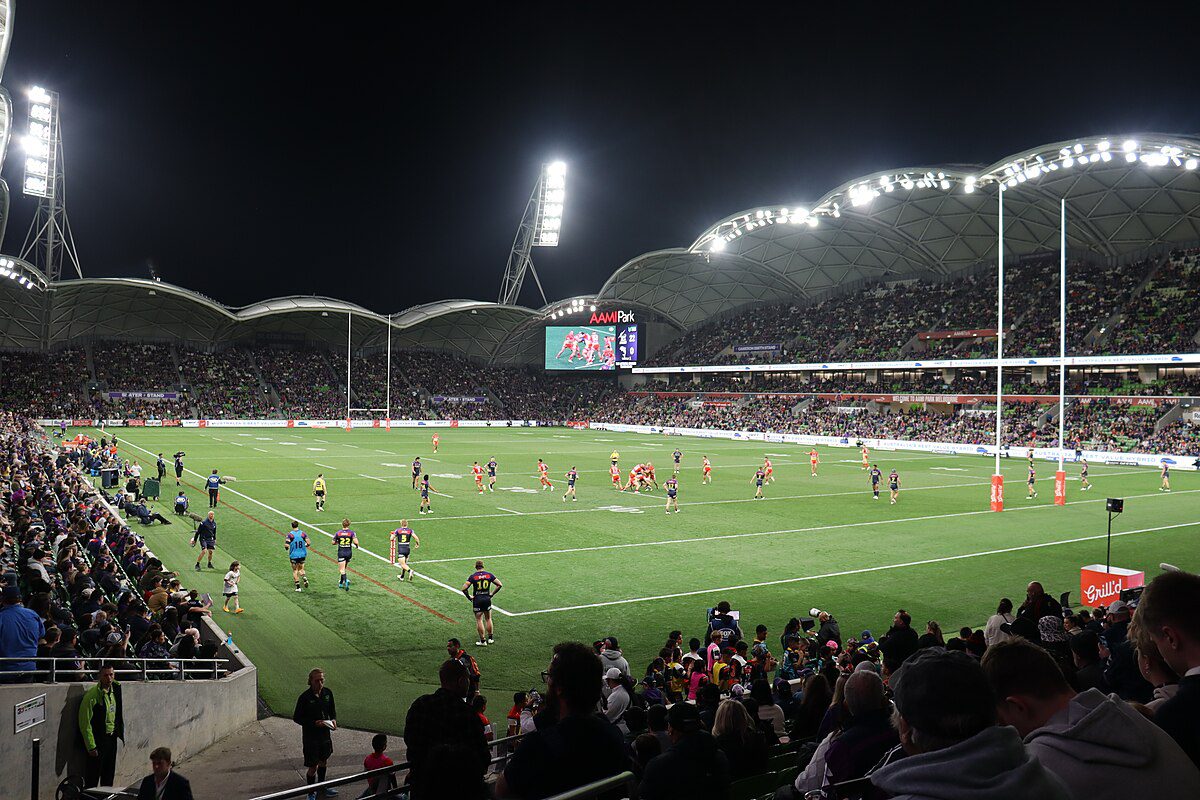NRL vs Super League: What are the Key Differences?

Image: “Melbourne Storm vs Dolphins, NRL 2024 Round 25 at AAMI Park” by EdwardJT, originally uploaded to Wikimedia Commons; licensed under Creative Commons Attribution-Share Alike 4.0 International (CC BY-SA 4.0)
Two countries, two competitions, and two very different stories of rugby league.
In Australia, Sunday’s National Rugby League (NRL) Grand Final will see the Brisbane Broncos look to repeat history as they play the Melbourne Storm, having beaten them in the 2006 final.
In England, the Super League Grand Final on 11th October could see a new champion crowned, with two of the four clubs that have ever won the competition absent from the semi-finals.
But between the two leagues, there are historical differences that have led to one league being the biggest in the world, and the other still struggling to find its feet.
Competition Structure
The leading league is, of course, the NRL, which was formed in 1998. It was the result of a peace deal between the country’s two parallel competitions at the time, following a year of decreased viewership and revenue, with the two merging to create a unified competition.
The NRL has boomed since then, with 17 teams currently competing amidst expansion plans for new sides to be introduced from Perth and Papua New Guinea, where rugby league is the national sport. These 17 teams, or franchises, are part of what is a fixed league that has never incorporated promotion and relegation.
In contrast, the Super League comprises 12 teams, some of which dating back to as far as 1864, and since then the competition has had a tumultuous approach to teams moving between the first and second tiers.
The most recent structure is known as IMG Grading, where teams are given an annual ranking based on factors such as viewership and performance. Grade 1 teams are admitted to the Super League are immune from relegation. Grade 2 teams make up the rest of the Super League and some of the second tier and can be promoted or relegated, while Grade 3 teams cannot be promoted to the Super League.
This format was voted for by 86% of clubs across the top five tiers of rugby league in the region, and it is one that strongly encourages investment by owners into their sides in order to gain the sought-after Grade 1 ranking.
Quality and Style of Play
In its 27-year history, 12 different teams have been named NRL Premiers. In contrast, only four sides have won the Super League since its inception in 1996, highlighting a clear discrepancy between the two competitions that contributes to a more competitive product in the NRL.
The NRL has further appeal when it comes to the playing style, producing some of the world’s greatest backs from Wally Lewis to Billy Slater.
Conversely, the Super League is known for the prominence of players in the forward positions and its more traditional style, with many English forwards moving to the NRL, including the four Burgess brothers and, more recently, Kai Pearce-Paul and Morgan Smithies – showing the quality England produces in these positions.
Part of this comes from factors as simple as the weather. Consistent rain and wind in the north of England, where rugby league is played most, means players are often coached to make fewer passes, as moving the ball around increases the risk of dropping it. Consequently, the forwards are relied upon to gain running metres.
Brian McDermott, former Bradford Bulls prop and current Newcastle Knights assistant coach, expanded on the impact of the weather on player quality when speaking to The Sporting News, who recently partnered with GIS to provide students with summer internships.
“If you just did quick numbers on a 10-year-old kid in England and tried to work out how many field sessions they would have in practice,” he explained, “quite often, the kid has got to get off the field in pre-season because it’s cold.
“I’m not just talking about, ‘Woo, it’s a bit chilly’, I’m talking about not being able to feel your hands. Even if the kid stays out there for some of the hundreds of field sessions…he couldn’t use his hands.”
Viewership
The Super League as a product is an entertaining one, and this year’s numbers prove it.
The 2025 season—which still has three games left to be played—boasts record-breaking numbers as more than 1.62 million fans attended matches over the course of the year.
Highlighting the competition’s growing popularity, attendances grew 9% from 2024, averaging over 10,000 fans per game for the first time ever. The Wigan Warriors drew over 17,000 fans to their home games including 20,000 to three of them, rivalling the tally of many NRL clubs.
Broadcast average viewing figures are also up by 52%, while digital impressions, engagements and video views have risen significantly by 68%.
Rhodri Jones, Managing Director of RL Commercial, says that the “Super League is in a stronger position than ever.” That said, it is far from reaching its potential, and must overcome a few hurdles before doing so.
The Super League, and the sport as a whole, has its fanbase concentrated in the north of England, with the southernmost English team being the Warrington Wolves, who are from Cheshire. Beyond them, there is no other Super League team until southern France, where there is another pocket of popularity.
Simultaneously, English rugby league competes locally with the world’s two most watched sports —football and cricket—while also often being overshadowed by rugby union, which is far less popular in Australia.
The popularity of other sports has led to the league struggling to negotiate favourable broadcasting deals, which is where the NRL has thrived.
Currently, three games a week are broadcast on Australia’s free-to-air Nine Network, pushing viewership figures to record highs. The 2024 NRL season attracted 7.3 million Australians who watched games occasionally or regularly—despite still being the country’s second-most-watched sports league behind the AFL.
Comparatively, only 15 Super League games are shown on free TV in the UK this season.
However, despite the prevalence of other sports, there is a significant population for the Super League to grow in England and France if investment is made to market it.
Between the two countries, the regions where the sport has a foothold are northern England and the Occitania region in southern France, with a combined population of over 30 million. This is similar to the population of Australia and much larger than the combined 14 million population of Queensland and New South Wales, the two states where rugby league is the main sport.
Finances
Overall, the success of a sporting league is largely dependent on how much money it makes. With other competing sports and less viewership, the Super League may not get the revenue a sport with its history deserves.
An example of the financial struggles lies in Super League clubs’ ability to reach the salary cap, which is at £2.1 million per club in the Super League and around £5.3 million (AUD9.4 million) in the NRL.
Partly due to the franchise model of the NRL, clubs benefit from significant central investment from the league itself, which had a revenue of $745.1 million in 2024 and a combined profit of over $250 million across the past four years.
This has resulted in each team being paid around $18 million a year—well above the salary cap.
In contrast, Super League clubs receive around £1.3 million, and need to find another £600,000 themselves if they want to fulfill their salary cap to lure higher quality players.
These struggles have reportedly been met with optimism by the NRL, who see the potential that the Super League has, with rumours of investment into the Super League gathering momentum.
Overall, the Super League has fallen behind the NRL, struggling to match the revenue and reach of its Australian counterpart. That said, England and France have rich histories in rugby league stemming back to the creation of the sport, and it is felt that despite recent struggles, the Super League’s heritage and passionate fans mean there’s a high ceiling when it comes to the competition’s potential.
Want to learn more about the behind-the-scenes of administration at sport’s highest level? Explore our sports degrees at GIS to gain a global perspective as you step into the fast-growing sports industry.
Article by Zakaria Anani
You may also be interested in
Our Partners
















